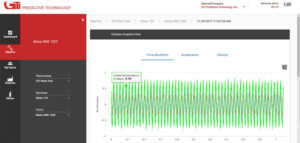Condition-based maintenance employs a strategy where maintenance is performed once one or more indicators show that equipment will fail or performance is deteriorating. Time-based maintenance tasks for machines shown to be running well are avoided, eliminating the possibility of introducing a defect into the system.
Condition-based monitoring (CBM) is the core of condition-based maintenance. Technologies, such as vibration analysis, motor current signature, ultrasound and oil analysis, are used to help assess machinery health and predict future failures. Prediction of failures allows maintenance to be planned on the user’s schedule, not the machine’s.

What are the advantages of a condition-based monitoring program?
• Improved system reliability
• Increased production
• Decreased maintenance costs
• Less human intervention, less human error influence
On-line CBM regularly provides the maintenance reliability information critical to machine health – on a schedule that cannot be accomplished with a route-based program. Trending of data is key to CBM, allowing the maintenance team to watch as conditions change over time. On-line solutions allow trends to be built much faster.
CBM has been a goal of many maintenance reliability programs. While CBM is recognized as the best way to monitor a plant’s assets, there have been many hurdles preventing implementation:
• Initial investment costs
• Lack of trained technical resources for analysis
• Dealing with an abundance of data
• Change management.
But all of this is changing. Just as in many other high-tech markets, new advances in computer hardware and software are bringing the cost of CBM technology down. Who would have thought 10 years ago that laptop computers would be available for under $1,000 or that most people would be carrying an Internet computer in their pocket?
Even as the cost is going down, advanced features are being added. Today’s CBM software allows problems to be readily identified and prioritized from machines that do not currently have problems. Trends can be built faster with on-line monitoring than with route-based programs. Modern networks allow the owner to outsource data analysis in real-time and “expert” software programs have improved greatly over the years.
Another technology that has experienced significant technical improvements along with decreasing costs is wireless communication. Greater amounts of data can be sent at greater speeds over greater distances with improved reliability. Wireless infrastructure reduces the cost of installation, eliminating the need to install conduit and pull cables. CBM systems of the future will feature wireless communication almost exclusively.
Why Cloud Technology?
First’s, let’s all understand what a cloud-based network is. The Cloud brings together a large number of computers to operate a single application.

In the past, network-based data collection and analysis required the use of a computer to not only host the data, but to handle traffic either through a server your company owns or one leases from a service provider. Under these circumstances, your company would require a data center, with several servers dedicated to collecting and processing condition data. This data, and the results, would be available only to computers on the network. Cloud computing leverages the power of the Internet to eliminate the need for the purchase, installation and maintenance of independent data centers and networks.
The cloud consists of layers, primarily the back end and the front end. The front-end layers are the ones you use and interact with. The back-end layers consist of hardware and software architecture that support the interface you see. Since computers are set up to work together, the applications take advantage of all that processing power and operate as if they were all running on the same computer.
Cloud computing offers:
• Reduced costs
• Easy maintenance
• Greater flexibility
• Unlimited (almost) data storage
• IT acceptance
• Greater profits
• Secure networking.
The Cloud provides access to machine condition data from anywhere in the world, by anyone with approved access, including third-party analysts, without having to add additional expensive infrastructure. This also makes it easier to monitor remote installations – pipelines, offshore drilling rigs, small facilities with limited resources – via existing Internet connections, 3G cellular technology, or satellite communication.
Machine Learning & Data Mining for Analysis and Fault Detection
Another advantage of Cloud storage of condition data is the abundance of data. Neural networks and artificial intelligence (AI) and other decision trees are incorporated develop predictive and fault detection. “Big Data” is used to improve fault diagnostic accuracy. AI software will forecast mechanical degradation and provide the user with the urgency to repair. More data equals better results and only Cloud data storage strategies can provide storage this capacity.
Data is collected and saved to the client database for access for local analysis. This data includes meta data. Metadata is “data that provides information about other data”. This includes information about the machine – name, location, running speed, alert & alarm levels, etc. When the “raw data” is sent to the machine learning Cloud, the meta data is stripped away so data from many sources can be combined (millions of data sets) to increase learning and accuracy.
According to Michael Jackson, co-founder of Adaptive Computing, “Cloud computing is becoming a priority for almost every IT organization in business today. According to a Pew Research Center survey, a decisive number of technology professionals predict that by 2020, most people will access software applications online and work through remotely-accessed networks.” Virtually every technology company is incorporating the word “cloud” somewhere in their description.
The rapid developments in Cloud technologies and services can only work to benefit the maintenance reliability community. All of these factors will work together to bring affordable, accessible and powerful condition-based monitoring products and services to every reliability program.

Paul Berberian is a Condition-Based Monitoring Specialist for VibePro. He has more than 12 years of experience in the maintenance reliability industry. www.vibepro.com
